Introduction
Background of the study
Diabetes Mellitus type 2 or Non-Insulin-Dependent Diabetes Mellitus is a metabolic disease. The patients experience an increased level of sugar in the blood as a result of insulin resistance or deficiency (Votey & Peters par.1). The disorder usually occurs during the adulthood stage hence it is sometimes referred to as Adult-onset Diabetes (Library &Isley par.1). Unlike type 1 diabetes, T2DM patients are not necessarily dependent on insulin because they can produce the hormone though in small amounts. The disorder is associated with complications of the micro-vessels (retinal vessels), macro-vessels (coronary vessels), and the neurons (neuropathy of peripheral and automatic neurons). However, there are no major incidences of acidosis associated with the disorder (Brian & Ivana 198).
Despite the disorder being reported in patients aged 40 years and above, recent studies indicate that it can also occur in children as young as 2 years old. This arises from increased rates of obesity and overweight cases among children besides their familial or genetic predispositions. Marginal insulin resistance and defects in insulin secretion are the main factors that cause the disorder when they occur in a normal person at that age (Boden 394). All overweight individuals experience insulin resistance. In case their body fails to increase insulin production, there is a high probability of them suffering from diabetes. Research findings reveal that over 90% of obese individuals will develop diabetes-related complications at some point in their lives. Other forms of the disorder have also been associated with genetic defects (Walley et al. 124).
Research studies conducted in 2005 indicate that over 70% of all United States citizens are diabetic. This represents approximately 20.8 million people of whom 14.6 million people are diagnosed with the disorder while 6.2million are undiagnosed. Approximately 90-95% of these people are type II diabetics while 5-10% suffer from type I diabetes. A small percentage of these individuals suffer from both types of the disorder while about 54 million people show blood sugar levels that are indicative of pre-diabetes (Ryden et al. 25). Globally, almost 171 million individuals suffer from diabetes. Scientific studies project that the number may increase up to 366 million people by 2030.
This essay examines the incidence rates of the disorder in the USA and globally including a variation of the prevalence rates amongst genders, populations, and countries. It also describes the associated causative factors of type II diabetes in addition to its impact on the United States and internationally. The essay also highlights reasons why the incidence of the disorder has been increasing over the past two decades and its potential effect on the health and economies of countries.
Diabetes Mellitus, Type II
The Incidence Rates of T2DM amongst Genders, Populations, and Countries
According to Wild et al (1047), there were approximately 177 million people with diabetes in the year 2000. About 2.8% of individuals of all age groups worldwide were diabetic while about 4.4 % of the world population is projected to be diabetic by 2030. This represents a total population of 366 million who will be diabetic by 2030. The prevalence of diabetes was also shown to be higher in males than females despite that there are more diabetic women than men.
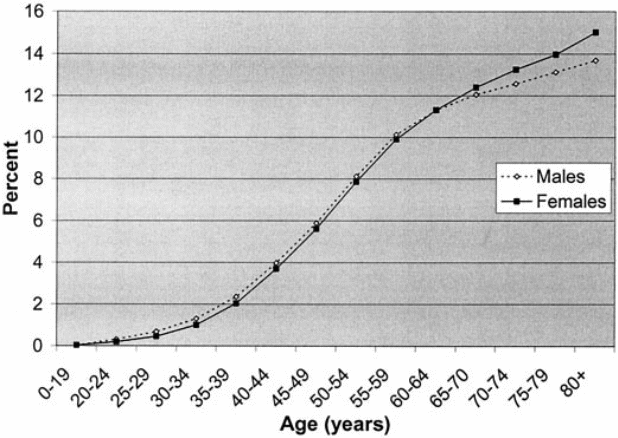
The graph above shows the worldwide prevalence of diabetes based on patient’s age and gender by 2000. On the other hand, the estimates for the prevalence of diabetes among countries are as indicated in the graphs below.
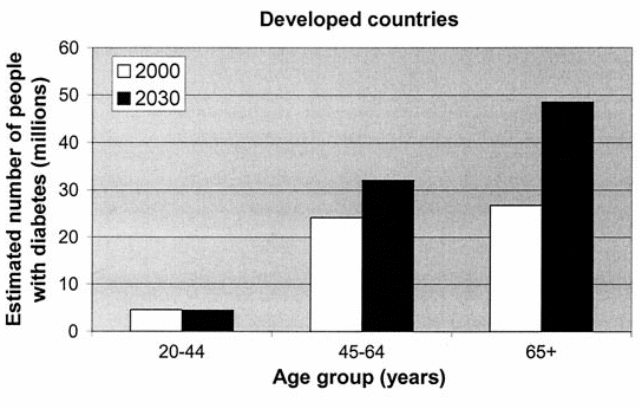
This graph indicates the estimates for adult diabetic patients in developed countries such as the United States and most European countries in the years 2000 and 2030.

This graph shows the adult estimates for diabetic patients in developing countries such as most African countries and the economically unstable communities in developed countries in the years 2000 and 2030.
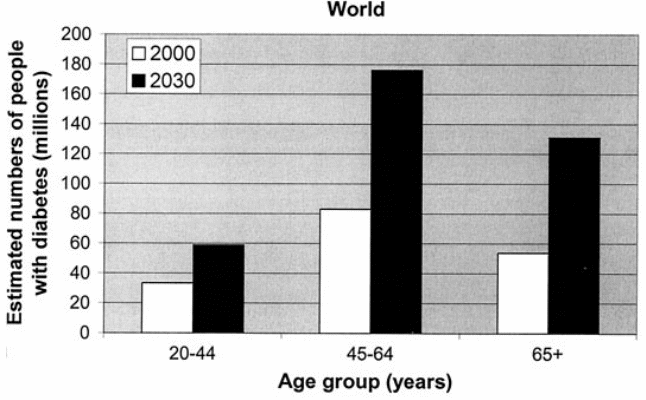
The graph above indicates the worldwide estimates for adult diabetic patients for the years 2000 and 2030.
By the end of 2010, the prevalence rate of diabetes is estimated to be approximately 6.4% among adults aged between 20 to 78 years worldwide (King & Rewers 157). This represents approximately 285 million people who will be suffering from diabetes worldwide. On the other hand, the rates are projected to increase to 7.7% by 2030, which is equivalent to 439 million adults with diabetes mellitus. Moreover, the results indicate that there will be an increment of 69% in the prevalence of diabetes in developing countries compared to a 20% increase in the developed countries (Shaw et al. 4).
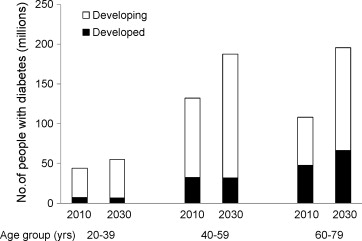
The graph indicates the estimated numbers of diabetic patients in 2010 and 2030 in developed and developing countries based on different age groups.
The Causative Factors Associated with Diabetes Mellitus, Type II
Several factors are identified to cause or aggravate the disorder. These include lifestyle factors, medical conditions, and genetic factors. Studies indicate that lifestyle factors are associated with a lack of physical activities among the susceptible groups of people in addition to leading sedentary lifestyles (Lovejoy 435). In addition, relying on unhealthy diets such as foods with high levels of saturated and trans-fatty acids which are associated with the development of obesity is also a cause of diabetes. Other lifestyle risk factors such as smoking, consumption of alcohol, and other environmental toxins cause the condition (Bloomgarden 1429).
Medical conditions associated with diabetes include combined hyperlipidemia disorder (high cholesterol levels), obesity, acromegaly, hypertension, cancer, and other metabolic syndromes. Hormonal imbalances particularly hypogonadism are also associated with diabetes (Farrell et al. 799). On the other hand, genetic factors and environmental changes are also a cause of diabetes type 2. For example, when an individual has first-degree relatives who are diabetic, the probability of that individual suffering from diabetes is relatively high. The same is true with obesity which contributes to about 55% of all T2DM cases.
Certain hereditary complications such as myotonic dystrophy and Wolfram’s syndrome are also associated with diabetes. Finally, the process of gene expression which is dependent on the levels of fats and glucose is also associated with the development of diabetes. This is because any changes in the levels of these food components can cause insulin resistance which is a major risk factor in the development of T2DM (Walley et al. 124).
The Impact of T2DM at the National and Global Levels
Diabetes mellitus is associated with the development of complications that lead to neuropathic, optic, cardiovascular, and renal diseases. Diabetes mellitus is one of the causes of increased morbidity and mortality rates in the United States. Studies indicate that cardiovascular complications associated with the disorder represent approximately 50-75% of the total expenditure by most patients. In addition, two-thirds of deaths among the diabetic population are related to heart failure and stroke (Lee et al. 187). Further, studies indicated the cost of treating diabetes compared to other diseases is about one to seven times the total cost of healthcare provision in the United States in 1994. By 2002, it was estimated that diabetes cost the United States economy more than $92 billion in direct funds with an additional $40 billion lost indirectly due to the disorder. This represents about 20% of the total healthcare cost per annum (Clement et al. 553). On the other hand, diabetes causes about 12,000-24,000 new cases of blindness in the United States annually. The disorder causes high levels of End-Stage Renal Disease (ESRD) and non-traumatic lower-limb amputations in the United States. Globally, the disease causes the highest incidences of blindness among adults aged 20-74 years besides being a major risk factor in the development of non-traumatic lower-limb amputations and ESRD.
A Critical Review of the Available Literature on the Shifting Incidence rates of Diabetes Mellitus in the Last 10-20 years
Diabetes Mellitus is a chronic disease whose symptoms and related complications take a long period to develop (Harris et al. 815). Studies indicate that the prevalence rates of the disorder increase exponentially annually (Center for Disease Control and Prevention par.3). In addition, studies conducted by employing the published materials on the recent and the projected future prevalence rates for the disorder based on gender, age groups, countries, and different populations, indicate that in 1997, an estimated 124 million people were diabetic worldwide. About 97% of these people were suffering from type II diabetes mellitus. During the same year, it was estimated that the number of diabetics would rise to 221 million people by 2010. The study also predicted that most of the cases would be in Asia, Africa, and among the economically challenged communities in the developed countries (Shaw et al. 13). In 2000, available resources indicate that the global diabetes prevalence rate was 2.8%. This represents about 177 million people worldwide. In the same year, the projections for the year 2030 indicated that about 4.4% of the world population, which is equivalent to 366 million people, will be diabetic. This represents a significant increase compared to data generated in 1997. The rise in the prevalence rate was attributed to increased rates of obesity worldwide. Moreover, the studies indicate that if the prevalence rates for obesity were to remain high for the next 25 years as from the year 2000, the estimated rates for diabetes would be higher than the current estimates.
Data released in 2001 indicate that approximately 150 million people in the world were diabetic. The projections for the years 2010 and 2025 indicated that the number would rise to 220 and 300 million people respectively. The greatest number of cases related to type II diabetes as a result of the rise in obesity cases and adoption of sedentary lifestyles (Mozaffarian et al 788). Additional studies estimated that the number of diabetic patients in the United States would increase with a margin of 23.7-44.1 million during the period ranging from 2009 to 2034. In line with the increase, the studies indicate that the number of obese and overweight individuals would be over 65% among the diabetic populations.
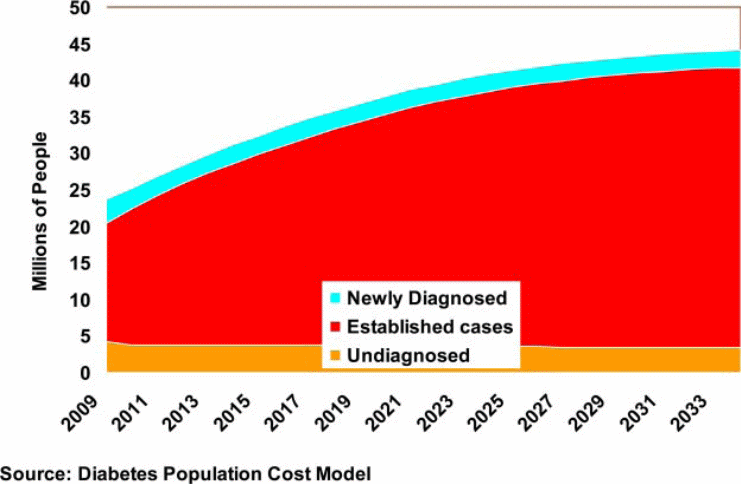
The graph indicates the estimated prevalence rates for diabetes mellitus among the newly diagnosed, the unknown causes, and the previously diagnosed patients during the period ranging from 2009 to 2034.
Limitations of the Available Literature
The studies indicate that the rates have been on the rise and the future projections indicate that the rates will continue to rise. However, the studies fail to provide ways of controlling the increment in the prevalence rates despite that they are providing the major causes and the impact of the disorder on world economies. On the other hand, the studies incorporate published resources only and fail to include the unpublished materials which can give additional information that can confirm or refute the claims made in such studies.
The Potential Effects of the Shifting prevalence rates on the health and economies of countries
Diabetes is a chronic disorder associated with several deleterious complications such as heart disease and stroke which are the leading risk factors in mortality and morbidity rates recorded worldwide. Its high prevalence implies that more deaths from such complications will be recorded (Zimmet et al 782). Many people will continue to suffer from complications associated with the disorder such as optic, renal, neuropathic, and cardiovascular diseases (Haffner et al. 562). The result is that many economies will suffer direct and indirect losses in terms of healthcare costs, lost time, and an ailing workforce (American Diabetes Association 596).
It is also estimated that the number of diabetic patients in the United States will increase with a margin of 23.7-44.1 million people in the years during the period ranging from 2009 to 2034. This implies that the total increase in the cost of healthcare will be $336 billion up from $113 billion in 2007 (Jonnson 5).
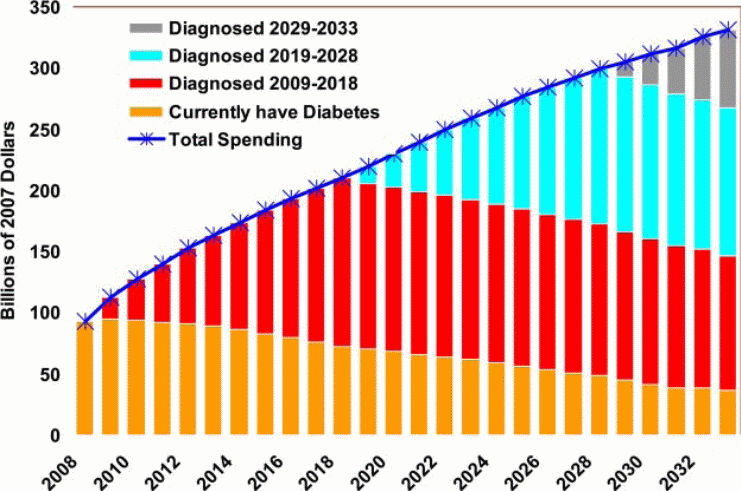
The graph above shows the estimated expenditure on diabetes and its related complications in the United States for the years 2008-2033. This increase is bound to have a negative direct impact on the budgetary allotment of many federal governments (Laditka et al 1301).

The graph indicates the estimated impact of the changing prevalence rates on the economies of many countries and governments in terms of direct, indirect, and total costs for the years 2002, 2009, and 2020.
The Future Areas of Research
From the above discussion, one can note that many of the studies carried out on diabetes mellitus are limited to estimations and projections of current and future prevalence rates of the disorder. However, more needs to be done about prevention. Numerous studies have identified the major risk factors in the development of diabetes. However, there is the need to devise intervention mechanisms to help in eliminating the risk factors before they advance to aggravate the problem. In addition, research should be conducted about the development of policies for education and intervention mechanisms that can enable many countries to control the prevalence rates of diabetes mellitus.
Conclusion
The essay provides a detailed account of type II diabetes mellitus which is a metabolic disorder characterized by increased blood sugar levels as a result of insulin resistance and insulin deficiency. The essay further provides the prevalence rates of the disorder amongst genders, populations, and various economies in addition to providing the causative factors associated with the disorder.
The essay also reviews available literature on the impact of the disease in the United States and globally based on the condition’s prevalence rates over the past two decades. Finally, the major areas for future research studies are also identified in the study.
It is worth noting that diabetes mellitus, type II is not a single disease in itself but comprises several complications which are mainly chronic and affect the micro-vessels of the eyes, the kidneys, and the neurons. Its impact on the economies of most countries comprises both direct and indirect costs incurred in terms of healthcare provision, lost time, and an underperforming workforce. As a result, there is a need to develop policies for education and intervention mechanisms to help in the control of the condition’s prevalence rate.
Works Cited
Amos, Antonio, McCarty, Daniel and Zimmet, Paul. The rising global burden of diabetes and its complications: estimates and projections to the year 2010. Diabetic Medicine. 1997; 14(5): 7-85.
American Diabetes Association. Economic costs of diabetes in the U.S. in 2007. Diabetes Care. 2008; 31:596–615.
American Diabetes Association. Economic costs of diabetes in the U.S. in 2002. Diabetes care, 2003; 26(3): 917-932.
Boden, Gregg. Fatty acids and insulin resistance. Diabetes Care. 1996; 19(4):394-395.
Bloomgarden, Zachary. Approaches to treatment of pre-diabetes and obesity and promising new approaches to type II diabetes. Diabetes Care. 2008; 31(7): 1461-1466.
Brian, Welch and Ivana Zib. Case study: diabetic Ketoacidosis in type II diabetes. Clinical Diabetes, 2004; 22(4): 198-200.
Clement, Siegel; Braithwaite, Song; Magee, Folli et al. Management of diabetes and hyperglycemia in hospitals. Diabetes Care. 2004; 27(2):553-591.
Centers for Disease Control and Prevention. National Diabetes Fact Sheet. United States. 2005. Web.
Farrell, Bowen, Deshmukh, Ann and Baghaie, Arnold. Low testosterone and the association with type 2 diabetes. The Diabetes Educator. 2008; 34 (5): 799–806.
Huang, Elbert, Basu, Anirban, O’Grady, Michael and Capretta, James. Projecting the future diabetes population size and related costs for the U.S. Diabetes Care, 2009; 32(12): 2225-2229.
Haffner, Simon, D’Agostino, Robert and Mykkanen, Loyd et al. Insulin sensitivity in subjects with type 2 diabetes. Relationship to cardiovascular risk factors: the Insulin Resistance Atherosclerosis Study. Diabetes Care. 1999; 22(4):562-568.
Harris, Ian, Klein, Ronald, Welborn, Timothy and Knuiman, Mathew. Onset of NIDDM occurs at least 4 – 7 yr before clinical diagnosis. Diabetes Care. 1992; 15(7):815-819.
Jonnson, Brewd. Revealing the Cost of Type II diabetes in Europe. Diabetologia. 2002; 45(7): 5-7.
King, Hans and Rewers, Martel. Global estimates for prevalence of diabetes mellitus and impaired glucose tolerance in adults: WHO Ad Hoc diabetes reporting group. Diabetes Care. 1993; 16(1): 157-177.
Laditka, Siegel, Mastanduno, Paul and Laditka, Newman. Health care use of individuals with diabetes in an employer-based insurance population. Arch Intern Med. 2001; 161(10):1301-8.
Lovejoy, Jones. The influence of dietary fat on insulin resistance. Curr. Diab. Rep. 2002; 2 (5): 435–40.
Lee, Cannon, Huxley, Robert , Lam, Harold et al. Prevalence of diabetes mellitus and population attributable fractions for coronary heart disease and stroke mortality in the WHO South-East Asia and Western Pacific regions. Asia Pacific Journal of Clinical Nutrition. 2007; 16(1): 187–92.
Ligaray, Patrick and Isley, William. Diabetes mellitus, type 2. Medscape. 2010. Web.
Mozaffarian, Dariush, Kamineni, Aruna, Carnethon, Mercedes, Djoussé, Luc, Mukamal, K.enneth and Siscovick, David. Lifestyle risk factors and new-onset diabetes mellitus in older adults: the cardiovascular health study. Archives of Internal Medicine. 2009; 169(8): 798–807.
Ryden, Lars et al. Guidelines on diabetes, pre-diabetes, and cardiovascular diseases. European Heart journal supplements. 2007; 9: 3-74.
Shaw, Jons, Sicree, Robert and Zimmet, Parlet. Global estimates of the prevalence of diabetes for 2010 and 2030. Diabetic Research and Clinical Practice. 2010; 87(1): 4-25.
Votey, Scott and Peters, Anne. Diabetes mellitus, type 2: a review. Medscape. 2010. Web.
Wild, Sarah, Roglic, Gojka, Green, Anders, Sicree, Richard and King, Hilary. Global prevalence of diabetes: estimates for the year 2000 and projections for 2030. Diabetes Care. 2004; 27(5): 1047-1053.
Walley, Andrew, Blakemore, Alexandra and Froguel, Philipe. Genetics of obesity and The prediction of risk for health. Human Molecular Genetics. 2006; 15(2): 124–130.
Zimmet, Paul, Alberti, Kenneth and Shaw, Jonathan. Global and societal Implications of the diabetes epidemic. Trans. Med. Soc. Lond. 2001; 78(16): 782-787.